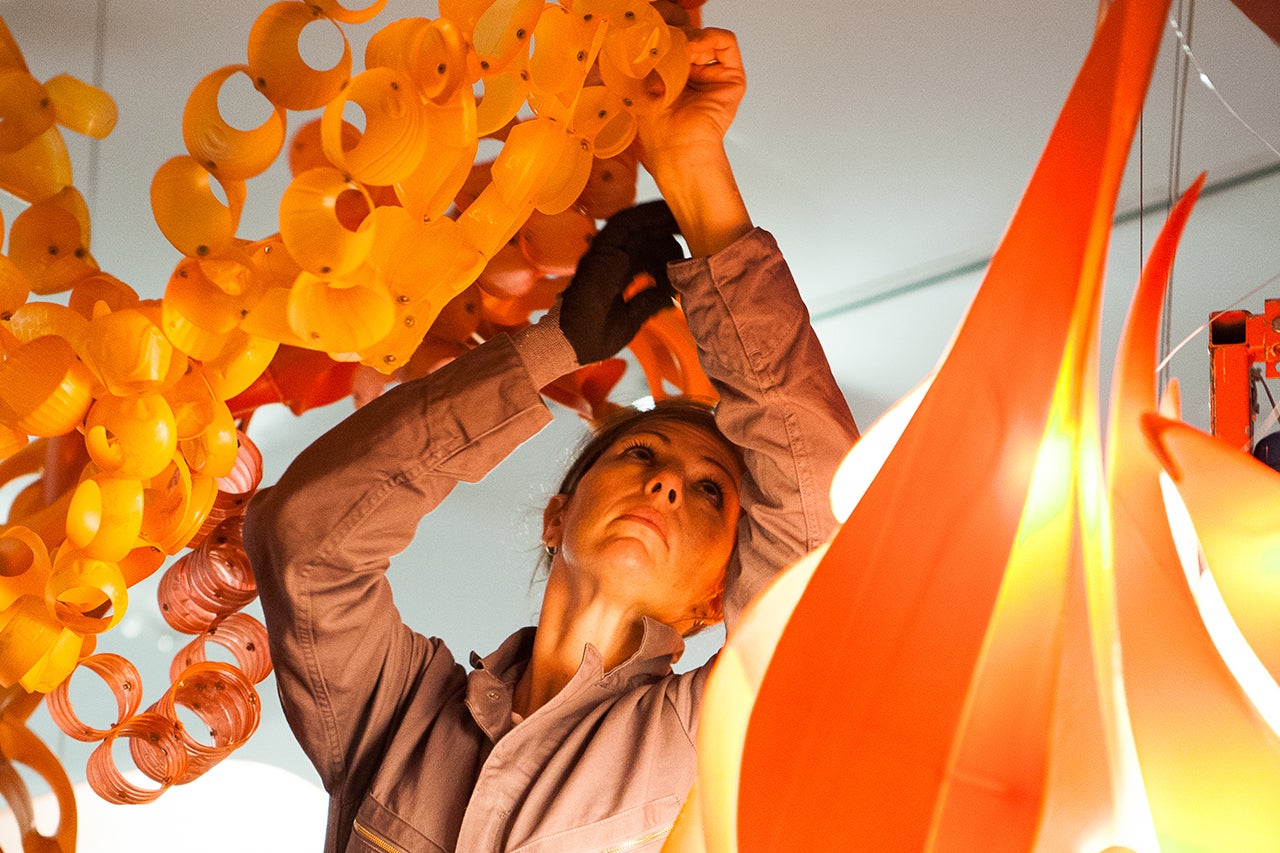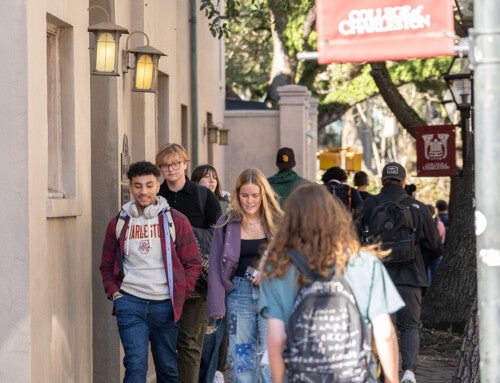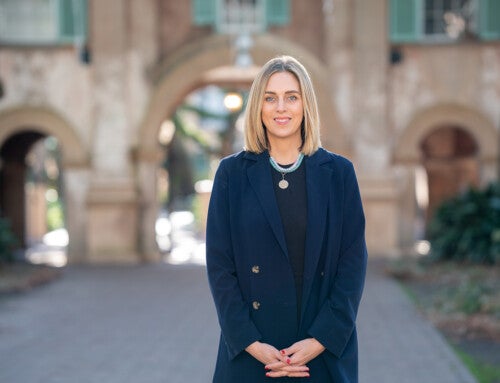Art can be a complex realm. Seeing artwork conveys certain levels of meaning, but new dimensions of understanding take shape when an artist discusses his or her own work. That’s why The College Today sat down with Chris Jordan and Aurora Robson – the two artists whose work is featured in Sea Change at the College’s Halsey Institute of Contemporary Art. Both artists are important voices in the world of environmental advocacy.
You work almost exclusively in repurposed plastic waste. How did you find your way to this unusual medium?
Aurora Robson: It happened almost accidentally. When I first started my practice full time, I was mostly focused on the basic premise of subjugating the negative experience I had as a child. There was a recurring nightmare that I had. It was terrifying. As an adult, I thought it would be an interesting study for me to take those memories and transform them into works of art that could somehow be inviting spaces for reflection. It was a very personal meditative process. While doing that, I kept coming across this material, this plastic debris. I kept noticing the correlation between the forms in the nightmares and this material. So, I thought maybe I could make these works in three dimensions using this material that seems to be everywhere.
At the time, I knew very little about the chemical composition of plastics and how they affect human health and I didn’t know that plankton are ingesting plastic and they’re responsible for 50 percent of the oxygen in our atmosphere. All I knew was how incredibly plastic that material is. It does whatever we want it to do, which is why it’s such a problem for the environment, but also why it’s such an ideal medium for art.
There appear to be elements of whimsy in your pieces. How do you reconcile that with the dire nature of the message your art conveys regarding the excess of plastic in our environment?
AR: I’m so glad you asked that. The point with the plastic waste stream, or any waste stream, is that there’s a trajectory to it – it’s moving. So, when there’s movement to anything, there’s the potential for changing the direction of that movement. My idea is, if it’s on this downward trajectory that will ultimately create all kinds of human and other health problems, then I have to switch the trajectory in the exact opposite direction for my work to be successful. So, the opposite of garbage, which is base and dark and low and depressing is something that’s uplifting and full of light. What I create is something that makes the whole idea of changing our habits fun, like a dance, or at least something pleasurable to engage in as opposed to a chore.
With the problem of plastic ocean pollution increasing, where do you derive your inspiration to continue working on this issue?
AR: Fortunately, I’m the kind of organism where irritation creates mutation. So, the more negative and dire the situation looks, the more propelled I am to do something to fix it. Plus, I’m involved in a lot of online listservs, so I can bear witness to what’s happening across the world in terms of plastic pollution and solutions. Last year, France banned single-use disposable plastics, which was a huge win. Other countries are banning bags, and places in the U.S. are banning bags, and there are films like “Bag It” and “A Plastic Ocean,” which are uplifting. It’s amazing how “Bag It” makes you feel empowered to make change.
What do you want students at the College to take away from your work at the Halsey?
AR: I want students here to know that they have the power to make big changes. They can make a bag ban happen. I’m sure a lot of people here in Charleston would line up to help them make that happen. So, my message is, work locally and do what you can. And be kind to yourself in the process.
How did you begin working in photography?
Chris Jordan: My father was a photographer who did stock photography when it really wasn’t a thing. That was sort of his side career. I learned from him. Early on, he took photo classes and shared that with me, too. He also collected fine art photography books. I think I got about the equivalent of a master’s degree in fine art photography through my dad.
How did you become involved in the issues with the albatross on Midway Island?
CJ: I was invited to a meeting arranged by an extraordinary activist named Manuel Maqueda. He’s not a wealthy guy, just a regular individual who learned about ocean plastic pollution maybe 12 years ago. He got so interested in it that he contacted all the people in the world who might know about this phenomenon – ocean scientists, the leading expert on ocean currents, a toxicologist, and a few other people – and personally paid for all of them to fly to Mountain View, California and have a meeting at the Google campus.
Another person there was Anna Cummins who subsequently co-founded 5 Gyres Institute, one of the foremost advocacy organizations involved in research and action around plastic ocean pollution. Anna had been a researcher on Midway Island. She had seen the plastic and knew about this phenomenon with the albatross. And at this meeting, I was learning that the great Pacific Garbage Patch isn’t something you can actually see. It’s not a giant floating mountain or a raft of plastic waste, it’s simply billions of pieces of plastic strewn around the ocean. Sometimes you can see rivulets, but it’s not something you can easily photograph, and that was the whole reason I was at that meeting. I was hoping to bum a ride on somebody’s research vessel to the middle of the ocean and photograph this giant island of garbage.
Well, that’s when Anna said to me, “if you want to make a photo of the Pacific Garbage Patch, go to Midway Island and look inside the stomachs of dead baby albatrosses.”
Something about what she said was so powerful. All of my work previously had involved looking at these global phenomena such as the number of cell phones discarded in the U.S. each day. I had been looking at things in the millions and millions. I had always taken the macro view. But the idea of seeing just handfuls of plastic in this incredibly remote place, that was stunning. I immediately got this image of the tip of an iceberg that’s poking up in just the most vulnerable, fragile, visceral place imaginable – inside the stomach of dead baby birds.
Some of your work from Midway Island can be challenging for the viewer. Sometimes to the extent that people find it off-putting. How do you react to that?
CJ: I’m aware that some people avoid my work, but here’s the thing: the whole intention of my film (Albatross) is to experience that feeling and go into that feeling of grief and sadness. People tend to think that allowing themselves to witness the suffering of animals is going to be traumatizing and cause depression, despair, or anxiety. They think it’s going to be a bad experience. Yet, my experience on Midway was different. When I was there witnessing the tragedy of baby albatrosses dying due to ingesting plastic, I just allowed that feeling to wash over me, and it turned out not to be a bad feeling. It wasn’t like happiness, it wasn’t a good feeling, but it was an incredibly deep and intense feeling – not of despair, but of love. And that’s what that sadness is.
The only reason we feel sad when we see other creatures suffering – when we learn about some loss that’s happening in the world – is because we love that thing. Otherwise, we wouldn’t feel anything at all. We would be indifferent. When you engage in that act of witnessing, a doorway opens and it’s a doorway back home into the deepest part of ourselves, where our love resides.
So, I want viewers to know that I carefully craft my work to avoid haunting them. My hope is that my images and my film are not only horrible, but they’re also beautiful. That’s what I’ve been trying to practice my whole career, taking photographs that are simultaneously so horrible that you can’t look at them, and so beautiful that you can’t turn away. You’re just sort of transfixed for a moment and in that moment, a key turns.”
What do you want students at the College to take away from your work in Sea Change?
CJ: I’m really interested in energetics between people. In the world of environmental activism, a lot of the energy you experience is despairing. It’s like a low-frequency blaaaah. You so often hear people say “Everything’s messed up. The news is really bad and it’s going to get worse faster and faster. We’re just screwed.” And when I visit with young people at high schools, that’s what they’ve got on their mind – “we’re screwed.”
If you’re a young person and that’s the foundational building block of your worldview, well, that’s just a horrible state to be in. So, I want young people to know that we can acknowledge this bad state of ocean plastic pollution, and we can also make fun of it because it’s so ridiculous. And, we can make art out of it that’s beautiful and quirky and wild and cosmic such as Aurora’s work.
However horrible the news, remember that it’s always wrapped in an envelope of exquisite beauty and mystery that is the miracle of our shared world. I think we can expand the energy that we hold the world’s problems in. We can acknowledge the despair, and – I’m a big fan of the word and – and we can be joyful. We can work on fixing the world. And, we can crack a joke about it because it’s really ridiculous.
Feature image: Artist Aurora Robson installs one of her pieces from the Sea Change exhibit. Photo by Reese Moore.







